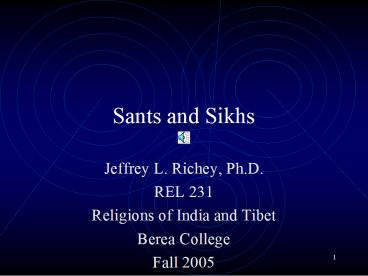Sants and Sikhs - PowerPoint PPT Presentation
1 / 10
Title:
Sants and Sikhs
Description:
regard God as nirgun (attributeless), to be known only by Name, not form ... Only meditation on God's name will liberate humans from samsara and facilitate ... – PowerPoint PPT presentation
Number of Views:184
Avg rating:3.0/5.0
Title: Sants and Sikhs
1
Sants and Sikhs
- Jeffrey L. Richey, Ph.D.
- REL 231
- Religions of India and Tibet
- Berea College
- Fall 2005
2
BACKGROUND TO SIKHISM SANTS AND NATHS
- Subsets of Hindu Vaisnava bhakti and Tantric
traditions - Popular in northern India between 1300s and
1700s - Sants (saints)
- regard God as nirgun (attributeless), to be known
only by Name, not form - reject ritual means of salvation
- prefer vernacular languages to Sanskrit
- Naths (masters)
- abandon external aids to devotion (temples,
idols, etc.) - reject caste system
- Rely on Naths as guides
- Most famous exponent Kabir
3
KABIR (1400s)
- Born in Benares (Varanasi) in north central
India to Muslim julaha (weaver) family - In spite of evident Muslim background, seems more
familiar with Vaisnava bhakti and Nath tantra
than with Islam - Uses poetry to express concept of God as
transcendent of all forms, especially theological
orthodoxies - Becomes focus of popular devotion in his own
right, with the result that his poems are found
in Hindu, Muslim, and Sikh collections
4
NANAK (1469-1539)
- Born near Lahore (in modern Pakistan) to Hindu
vaisya family - According to tradition, at age 29 has near-death
experience in bathing pool, the result of which
is the insight I shall follow Gods path.
God is neither Hindu nor Muslim and the path
which I follow is Gods. - Attracted sikhs (disciples) with his teachings
- God is one (ek) and known only by nam (name), not
form - Haumai (self-centeredness) and maya (illusion)
separate humans from God - Only meditation on Gods name will liberate
humans from samsara and facilitate eternal union
with God - Succeeded by nine gurus, all later seen as his
reincarnations
5
AMAR DAS (1479-1574)
- Second successor to Nanak
- Devout Vaisnava Hindu until old age
- In spite of Nanaks rejection of external
festivals, pilgrimages (tirath), and rituals,
Amar Das establishes pilgrimage center at
Goindval (Puñjab) with related festivals and
rituals - Builds baoli (well) to which 84 steps
(corresponding to 8,400,000 types of Hindu
rebirth) lead, as ritual focus for anti-ritual
performance - Begins compilation of Sikh scriptures
6
ARJAN (1563-1606)
- Son of fourth guru, Ram Das (1534-1581), and born
in Goindval (by now, major Sikh center) - Begins construction of Golden Temple in Amritsar
(Puñjab), which eventually replaces Goindval as
major Sikh center - Compiles Sikh scriptures in Adi Granth (Original
Book), to which writings of his successor also
are added, and which eventually functions as guru
in its own right - Executed by Mughal authorities, allegedly for
promoting Hindu and Muslim heterodoxies
7
HARGOBIND (1595-1644)
- Son of fifth guru, Arjan
- Leader of panth (Sikh community) at time when its
growing size emerges as threat to Mughal rule in
Puñjab - Responds to Mughal hostility by relocating panth
from Puñjab plains to Sivalik region (Himalayan
foothills), center of Hindu Devi (Great Goddess)
bhakti, in which sakti (energy) is cultivated by
male devotees through devotion to female deity - Emphasizes need for Sikhs to defend themselves
militarily from Mughal aggression
8
GOBIND SINGH (1666-1708)
- Tenth and final guru
- Regards Sarab-loh (All-Steel) as Gods true name
and uses sword imagery extensively in innovative
rituals - Credited with establishment of Khalsa (Army of
Purity), a military order within panth, members
of which are distinguished by - kes (uncut beard and hair)
- carrying kangha (comb)
- wearing kara (bangle)
- bearing kirpan (dagger)
- wearing kacch (short pants)
- adopting name Singh (lion) if male, Kaur
(princess) if female - abstinence from intoxicants
- daily ritual bathing and meditation
- avoidance of association with Islam
9
SIKHISM AFTER THE GURUS
- Adi Granth, also known as Guru Granth Sahib
(Lord-Master Book) replaces human gurus - Copies become sacred center of Sikh gurdwaras
(temples) - Ranjit Singh (1780-1839) defeats Mughals and
established independent Sikh kingdom, Khalistan
(Land of Purity) in what is now Pakistan, which
endures until defeat by British in 1849 - Puñjab divided by Partition in 1947, forcing over
2 million Sikhs to relocate - Dream of Khalistan still animates separatist
violence today (e.g., Sikh assassination of
Indian prime minister Indira Gandhi in 1984)
10































